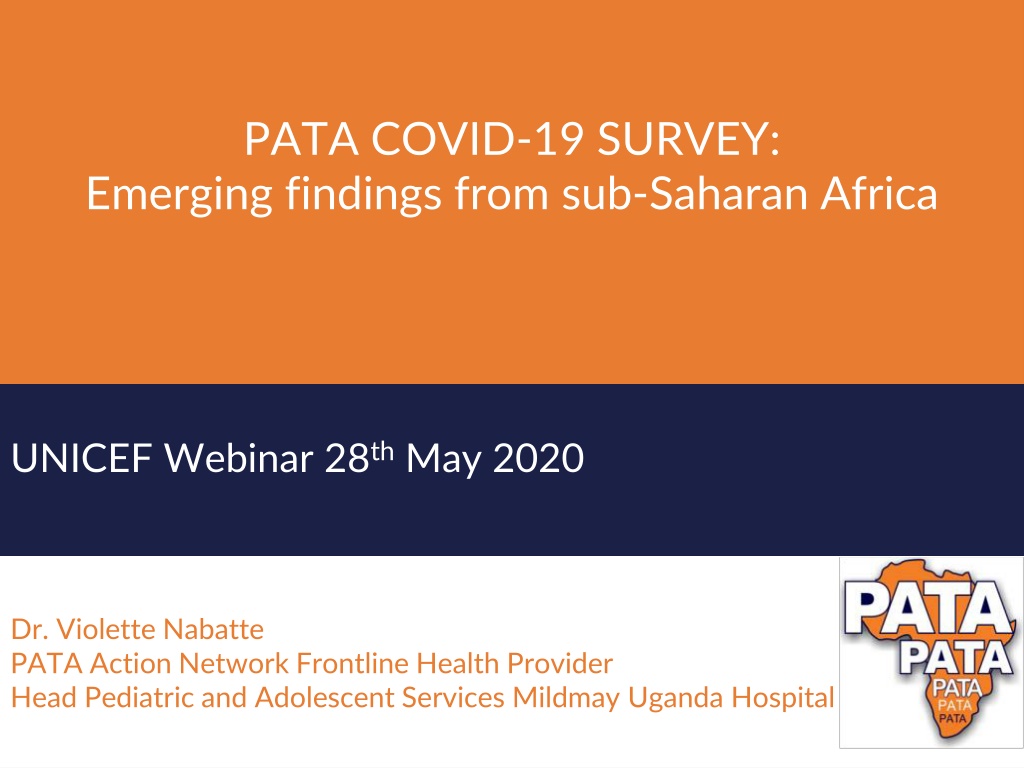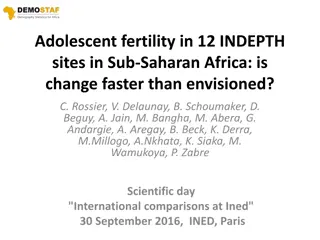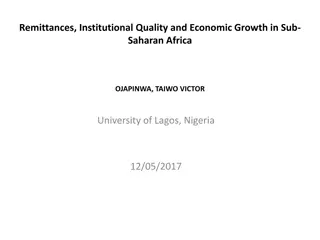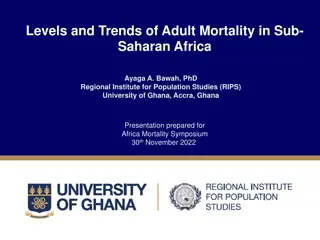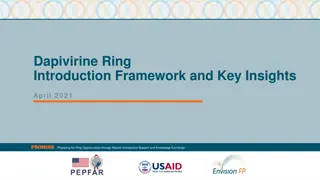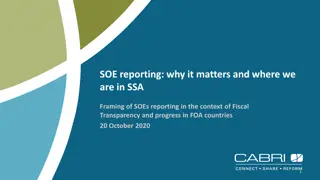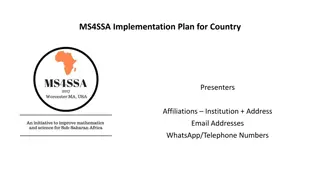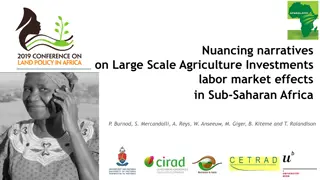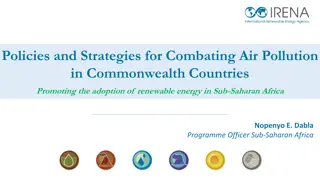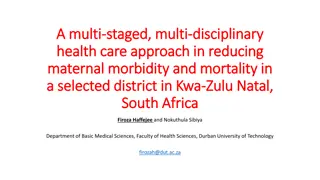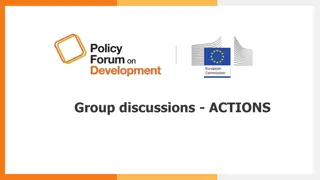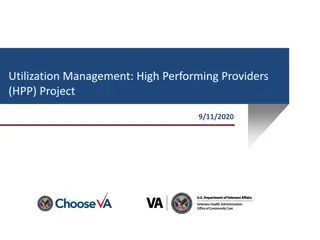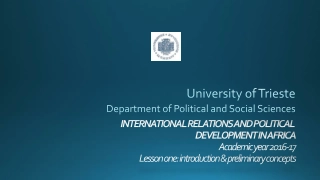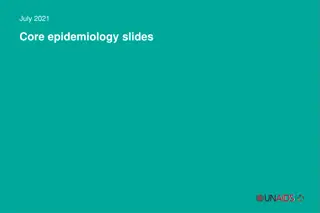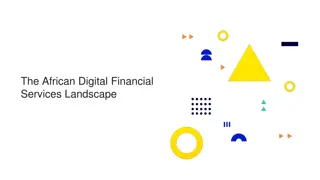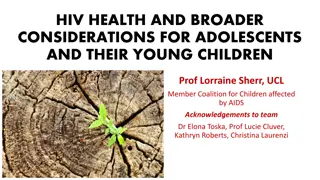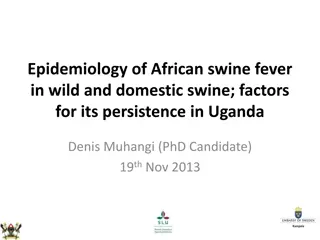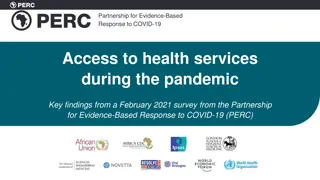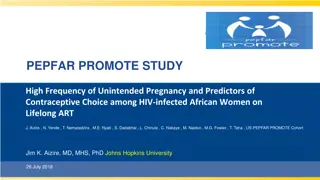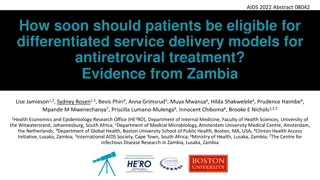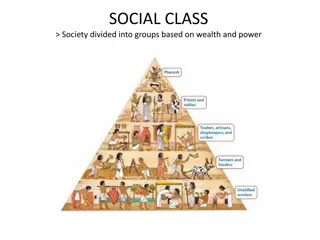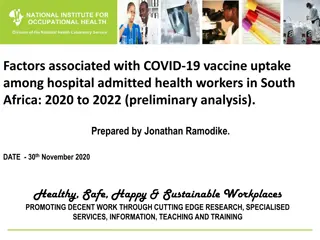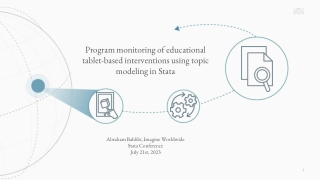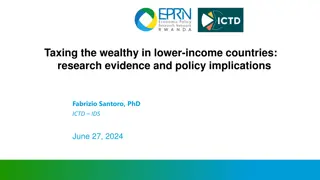Insights from Sub-Saharan Africa: COVID-19 Impact on Health Providers
Emerging findings from a survey in sub-Saharan Africa highlight concerns on how COVID-19 affects essential health services, particularly for HIV, TB, and malaria patients. The survey aims to identify critical gaps in the response to COVID-19 and prioritize support for frontline health providers. Majority of respondents are involved in delivering services for children and adolescents with HIV. Challenges include the lack of reliable information, training needs, and essential care during the pandemic.
Download Presentation

Please find below an Image/Link to download the presentation.
The content on the website is provided AS IS for your information and personal use only. It may not be sold, licensed, or shared on other websites without obtaining consent from the author. Download presentation by click this link. If you encounter any issues during the download, it is possible that the publisher has removed the file from their server.
E N D
Presentation Transcript
PATA COVID-19 SURVEY: Emerging findings from sub-Saharan Africa UNICEF Webinar 28thMay 2020 Dr. Violette Nabatte PATA Action Network Frontline Health Provider Head Pediatric and Adolescent Services Mildmay Uganda Hospital
Rationale Uncertainty about how COVID-19 will affect essential health services, especially given high burdens of disease with HIV, TB, and malaria Objectives of the survey: To better understand critical gaps and needs in COVID- 19 response and possible impacts on HIV service delivery To amplify the voices of health providers across sub-Saharan Africa, highlighting their reality and prioritizing areas of support needed to fight the pandemic
Demographic profile 188 respondents from 17 countries, most responses from East and Southern Africa. Majority (96%) of respondents involved with providing services, care, or programming for children, adolescents, and young people living with HIV. 93 respondents (49%) were involved in clinical roles, as doctors, nurses, midwives, or counsellors : this group is referred to as health providers
Location of work Respondents were employed at primary level facilities (n=73), secondary level facilities such as local or district hospitals (n=79), and tertiary facilities such as regional or provincial hospitals (n=36). Half of all respondents work at urban-based facilities, while 25% work in peri-urban settings and 25% in rural settings . Rural 25% Tertiary 19% Primary 39% Urban 50% Peri- urban 25% Secondary 42%
Preparing for COVID-19: information and training Of all 188 respondents, 15% said that they did not have access to information that is reliable, helpful, and practical, and 70% cited needing more information. Similarly, respondents identified their communities most pressing need as access to information and awareness on COVID-19 on how to keep themselves safe and healthy. Respondents overwhelmingly cited the need for more information and training on COVID-19
Preparing for COVID-19: information and training How to treat and care for someone with COVID-19 93% How to support colleagues and patients that show signs of distress and anxiety 84% How to identify and diagnose someone with COVID-19 80% How to manage other routine services during COVID-19 80% How COVID-19 is affecting my country and region 78% How to keep myself and my family safe from COVID-19 60%
Treating and caring for COVID-19 patients: EID What works? What impact that COVID-19 has on those who are living or personally affected with HIV/AIDS (Community worker, Zambia) Managing other routine services during COVID-19: What I should tell my peers to do when their appointment dates come, because there is no transport? (Peer supporter, Uganda) Keeping myself and my family safe from COVID-19: How to live with a person who recovered from the disease and came back to the family (Clinician, Tanzania)
Preparing for COVID-19: systems and SOPs 24% of respondents reported that their facilities did not have any protocols or clinical SOPs related to COVID-19, with 55% reporting needing more Regarding protocols and clinical SOPs for infection prevention and control to ensure health safety, 22% of respondents reported having none at their facilities, 60% needing more 22% of all respondents reported that their facilities had no systems for managing physical distancing in their facilities
Protocols and SOPs on infection prevention and control for health facility and staff 17% 23% We don't have this at all 25% 22% 64% 62% We need more 55% 60% 14% 13% We have enough 11% 12% 6% 8% I don't know 10% 6% 0% 10% 20% 30% 40% 50% 60% 70% Tertiary Secondary Primary Total
Protocols and clinical SOPs related to COVID-19 14% 25% We don't have this at all 29% 24% 61% 59% We need more 48% 55% 14% 8% We have enough 14% 11% 11% 8% I don't know 10% 9% 0% 10% 20% 30% 40% 50% 60% 70% Tertiary Secondary Primary Total
EID What works? Longer hours in the past week Providing health education and counselling for children and young people living with HIV on COVID-19 and adherence (Programme manager, Zimbabwe) Planning work schedules for personnel in my department, encourage my pregnant women patients to show at appointments and take the ARVs (Midwife, Cote d Ivoire) Responding to emergency plans for children focusing more on mental health issues and protection from abuse - higher probability in confined spaces during lockdown (Mental health consultant, South Africa)
Psychosocial support and stress Current reported level of stress about COVID-19 4% 26% Extremely stressed Very stressed 44% Quite stressed Not at all stressed 27%
Stressors Individual: Risk of being infected with COVID- 19 while caring for others (Nurse, Zimbabwe) Community: If it strikes in our community of operation, would people really survive? (M&E Officer, Kenya) Systems: How COVID-19 is affecting the daily life of citizens (Clinician, Tanzania)
Resource Needs We have enough We need more We don't have at all Don't know RESOURCES TO DIAGNOSE AND CARE FOR COVID-19 PATIENTS COVID-19 test kits 1% 26% 63% 11% Drugs to treat COVID-19 2% 24% 52% 22% Respiratory support 1% 35% 57% 7% Supplies for supportive care 4% 56% 33% 7% RESOURCES TO PREVENT COVID-19 TRANSMISSION Sanitizer 3% 76% 18% 3% Handwashing supplies 20% 71% 6% 3% PPE Gloves 7% 74% 15% 4% PPE Gowns 3% 43% 50% 4% PPE Masks 2% 62% 32% 4%
SYSTEMS AND INFRASTRUCTURE Systems: physical distancing 15% 59% 22% 3% Systems: triage patients 13% 53% 22% 12% Protocols and infection prevention and control SOPs 12% 60% 22% 6% Protocols and clinical SOPs related to COVID-19 11% 55% 24% 9% Additional staff 7% 49% 32% 11% Space and/or beds 12% 53% 27% 9% OTHER RESOURCES FOR USUAL CARE 3-6 month ARVs or chronic meds 27% 61% 5% 7% Chronic drug including ARVs 33% 59% 2% 7% Essential drugs 10% 64% 17% 10% 0% 10% 20% 30% 40% 50% 60% 70% 80% 90% 100%
Key take away Primary and secondary health facilities are: Less prepared for COVID-19 Less able to continue essential HIV services Reasoning being: Less access to information and training High level of stress and with several stressors High needs for a variety of resources Last but not least health providers will be affected as the pandemic takes hold in Africa, we need more data on health worker infections and deaths. Call to action: all frontline health providers need some level of preparation, support and additional resources to respond to COVID-19 as well as continuing essential HIV service delivery.
Thanks We thank all of the contributors to this survey every voice counts. #NothingForUsWithoutFrontlineHealthProviders Health providers at the frontlines of service delivery
